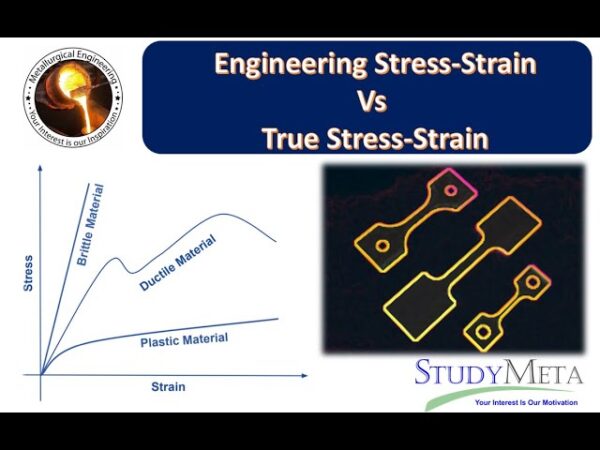Aluminum alloys offer engineers desirable qualities like light weight, corrosion resistance, high strength-to-weight ratios, and excellent thermal and electrical conductivity.
However, for structural design applications, aluminum’s lower elastic modulus compares unfavorably to steel.
As an intensive property independent of geometry, aluminum’s Young’s modulus ranges 65-75 GPa, around a third that of carbon steel.
This lower modulus indicates greater elastic deformability under load, affecting engineering considerations around deflection control and stiffness.
Understanding exactly how processing and testing parameters quantitatively impact aluminum’s modulus empowers engineers to select alloys and temper treatments optimized for modulus-dependent application requirements.
This article will provide a technical deep dive into the Young’s modulus of aluminum –
- how intrinsic crystal structure and defects influence modulus values compared to steel.
- how precipitate hardening, cold working, and alloy composition affect modulus.
- quantifiable impacts of temperature and strain rate during testing, and relevant measurement standards.
Effect of Heat Treatment on Young’s Modulus of aluminum
Heat treatment modifies the microstructure of aluminum alloys, directly impacting mechanical properties like Young’s modulus.
Solubilization followed by aging generally increases the elastic modulus through precipitation hardening mechanisms.
Reported elastic modulus values for 6061 aluminum increase up to 14% when age hardened compared to solution treatment.
Why is Young’s Modulus of aluminum Lower Than Steel
Aluminum has a face-centered cubic lattice at the atomic level, allowing more slip plane deformation than steel’s body-centered structure.
More deformation along slip planes means lower resistance to uniaxial loading and thus lower elastic modulus values for aluminum (around 68-70 GPa) compared to steel (around 200 GPa).

Highest Young’s Modulus of aluminum alloys Values
Although lower than steel, premium aerospace grade aluminum alloys like 2024, 7075, 6061 can reach Young’s modulus values of 73-75 GPa in peak aged tempers thanks to alloying additions like Cu and Mg.
Particle reinforced composites with SiC or Al2O3 have reported modulus values approaching 100 GPa as reinforcement hinders lattice distortion.
Relationship Between Young’s Modulus and Aluminum Strength
While strength relies on impeding dislocation motion, Young’s modulus correlates only with atomic bonding force resisting elastic lattice distortion.
However, precipitate hardening methods that impede dislocations also stiffen the lattice, leading to some indirect correlation between higher aluminum alloy strength and modulus values.
How to Calculate Young’s Modulus for Aluminum Plate
Young’s modulus is calculated by dividing tensile (or compressive) stress by axial strain in the elastic deformation region before yield.
For aluminum plate, ASTM E111 describes the standard test method, usually via extensometer strain measurement.
Resulting modulus values can range 65-75 GPa depending on alloy and temper.
Young’s Modulus – Aluminum 6061-T6 Temper
6061-T6 aluminum has a typical Young’s modulus value around 69-70 GPa.
The T6 heat treatment temper indicates solution heat treating followed by artificial aging to achieve peak strength, which also maximizes elastic modulus compared to lower temperature tempers like T4 through precipitation hardening effects.
Aluminum Young’s Modulus vs. Temperature Graph
Young’s modulus decreases nearly linearly as temperature increases, as elevated temperatures excite increased atomic vibration, reducing bonding force and lattice resistance to elastic distortion.
Aluminum experiences around a 4% reduction in modulus between room temperature and 250°C.

Cold Worked Aluminum Improved Young’s Modulus
Plastically deforming aluminum via cold working strains the lattice beyond yield, causing lattice defects andDISTORTIONS that hinder dislocation motion, restricting elastic deformation and increasing Young’s modulus.
Up to 7% higher modulus values are reported for heavily cold rolled 5xxx and 6xxx aluminum.
Young’s Modulus Aluminum Alloy Test Method Standards
ASTM E111 using strain gauges or extensometers is the standard test method for dynamically determining aluminum Young’s modulus.
Alternately ISO 6892-1 (tensile test), ASTM C747 (ultrasonic), or ASTM E1875 (resonant frequency and damping) also characterize modulus. Specimens are usually small plates or cylinders.
Impact of Strain Rate on Aluminum Young’s Modulus Measurement
Aluminum exhibits slight modulus dependence on strain rate – reported shear modulus under ultrasonic frequencies (~104 Hz) is around 5% higher than quasistatic strain rates (~10-3 Hz).
This viscoelastic behavior requires matching test strain rate to the end-use application profile when material data is generated.






